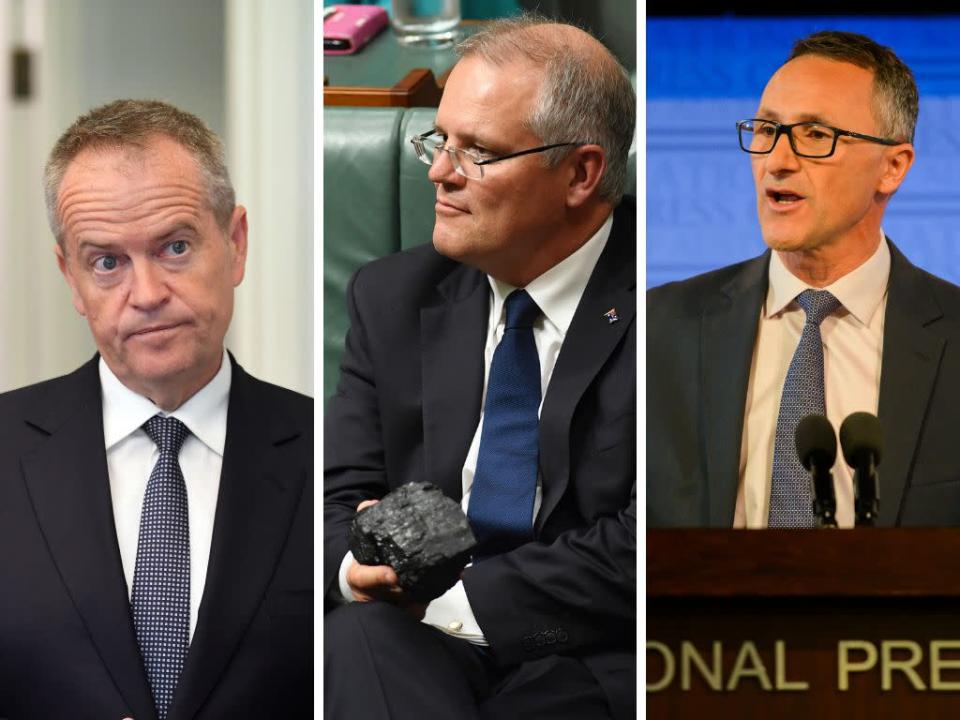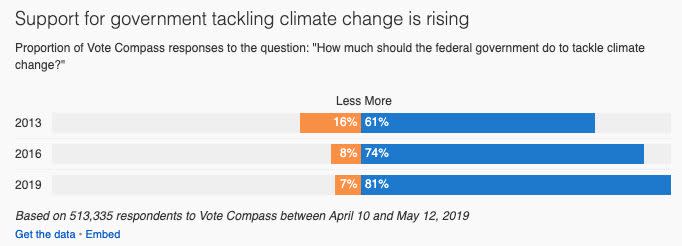Labor vs Liberal vs Greens: If you care about tackling climate change…

Yahoo Finance will have the election covered this Saturday. Stay tuned to thewebsite and your inbox for our coverage.
The issue of the environment and climate change had risen to the fore as a key issue for Australians well before the federal campaign trail began.
It was concern about the government’s inaction on climate change that prompted thousands of Australian students in Melbourne, Sydney, Adelaide, Canberra and Hobart and beyond to walk out of their classrooms to go on strike two months ago.
It was one of the issues that delivered Kerryn Phelps her by-election victory in Wentworth, and looks set to decide whether former prime minister Tony Abbott gets to keep his seat in Warringah.
And it was a divided Coalition’s stance on climate change that saw Malcolm Turnbull toppled from his position as opposition leader in 2009 then again as Prime Minister in 2018.
For the Greens, climate change and the environment represents their chief policy pillar and is, indeed, their raison d’etre.
Compared to the last two federal elections, the number of Aussies wanting government to do more to combat climate change is rising, according to ABC’s VoteCompass.

So let’s take a look at what the three major parties are planning to do to tackle climate change:
If Labor wins the election….
To tackle climate change, Labor has 10-point plan, a document that runs across 20 pages with its own standalone website. This is what the plan details:
1. Ensuring 50 per cent of Australia’s national energy is from renewable sources
Labor wants 50 per cent of the country’s energy source to be from renewable energy, and they anticipate investment in renewable energy will create 70,000 new jobs.
The party will also double investment in the Clean Energy Finance Corporation; create a $5 billion Independent Energy Security and Modernisation Fund; set a target to have 1 million household battery systems by 2025 and provide a $2,000 rebate for 100,000 households earning less than $180,000 a year for battery systems; create a Neighbourhood Renewables Program so renters and social housing residents can get cheaper, cleaner energy; and develop the bioenergy industry.
2. Implement their ‘National Energy Plan’ to help regional communities and businesses transition from coal power
Coal-fired power stations are in their last days – but shutting these down threaten the livelihoods of regional workers.
To tackle this, Labor will create a Just Transition Authority body that connects workers, unions, communities and government departments to help with the transition, and require large generators give notice of closure three years ahead of time.
3. Introduce a ‘National Electric Vehicle Policy’
Labor believes Australia’s take-up of electric vehicles (EVs) is too slow. In order to reduce barriers and speed this up, Labor is establishing a National Electric Vehicles Policy, which will see a national target of 50 per cent of new car sales to be made up of EVs; they plan to lead the way, with 50 per cent of government cars to be EVs by 2025; dedicate $200 million to rolling out EV charging infrastructure across the country; reform regulation; create an EV Innovation and Manufacturing Strategy; and introduce vehicle emissions standards to reduce pollution.
Labor will also provide support to heavy vehicles, public transport and other transport in reducing pollution.
4. Partnering with businesses to find ways to bring down pollution and create new jobs
In order to ensure key industries don’t lose out in the transition to cleaner energy, Labor wants to create low carbon strategies tailored to industries such as steel, aluminium, and cement, as well as establish and funnel $300 million to a new Strategic Industries Reserve Fund over six years.
5. Spend $1 billion to kickstart the ‘hydrogen economy’
Labor sees a lot of potential in the hydrogen industry, as well as major export opportunities with our Asian neighbours.
To take this further, Labor plans to support this sector by redirecting and investing funding through research, development, commercialisation, infrastructure and regulatory reform.
A cool $3 million will be dedicated to setting up a new National Hydrogen Innovation Hub in Gladstone to kick-start commercialisation of hydrogen technologies.
6. Getting Australia’s biggest polluters to cut down on pollution
Labor will extend on the ‘Safeguard Mechanism’, which was created to cap industrial pollution of big companies by setting limits. Any companies that emit more pollution than their baseline will have to offset their excess emissions by buying offsets from the land sector or other sources.
Under Labor, the Emissions Reduction Fund will be scrapped; the Carbon Farming Initiative will be strengthened; and a certification framework, called a Carbon Assessment Standard, will be created.
7. Bringing back the Carbon Farming Initiative
Hand in hand with the previous point, Labor wants to strengthen the land offset market by helping the meat industry be carbon neutral by 2030; increasing land sector abatement opportunities; boosting the research and development of carbon farming; allowing the federal government to intervene on broad-scale land clearing; and develop new strategic plans for the forestry industry.
8. Increase energy efficiency
In order to raise Australia’s energy efficiency and help Aussies cut back on power bills, Labor will allow the Australian Renewable Energy Agency (ARENA) to more broadly support energy efficiency projects; increase the Clean Energy Finance Corporation’s focus on such projects; provide a thousand Aussie manufacturers with $20,000 grants to engage experts on energy management; developing an accreditation system for auditors and training programs for manufacturers; and committing $10 million to an energy efficiency reforms of COAG.
9. Reviving Australia’s international engagement on climate change
Labor will seek to undo some moves made under the Coalition government, such as reinstating a Climate Change Ambassador and engage with our Pacific Island neighbours to provide leadership, assistance and advice on climate change issues.
10. Restoring the Climate Change Authority
Labor wants to further reinstate climate change institution abolished under the Coalition such as the Climate Change Authority tasked with assessing the national impacts of climate change.
Labor will also introduce a triennial Australian Climate change Assessment (ACCA) that details the likely impacts of climate change on Australia’s environmental, social, and economic systems.
A National Strategy on Climate Change and Health will also be developed to address the health impacts of climate change.
If Liberal-National Coalition wins the election…
These are the Coalition’s broader policies on cleaner energy and a cleaner environment:
1. $2 billion for a Climate Solutions Fund
Building on the Emissions Reduction Fund, the Coalition plans to dedicate $2 billion to the Climate Solutions fund aimed at helping farmers, small businesses, and Indigenous communities reduce their emissions and lower energy costs.
2. Building Snowy 2.0
If re-elected, the Coalition government has promised to construct a second hydro-electric power station, ‘Snowy 2.0’, which aims to be the second-largest in the world. It will provide enough energy to power 500,000 homes.
3. Making Tasmania the ‘Battery of the Nation’
Scott Morrison announced he would back the construction of a second undersea power interconnector aimed at bringing more hydroelectric power generated in Tasmania into the mainland.
4. $22 million for ‘Cleaner, Greener Local Communities’
Under the Coalition, every federal electorate will receive up to $150,000 in community-led projects aimed at delivering environmental benefits such as restoring wetlands, waterways, protecting native animals, reducing waste and litter, and making local parks and urban areas more ‘green’.
The Greens’ policy on climate change
The Greens intend on creating a renewable economy that tackles climate change, creates jobs, makes bill cheaper and energy more reliable.
Its plan to do so involves:
1. Phase out coal exports by 2030
The Greens pledge to phase out thermal coal exports by 2030 by setting a yearly limit from 2020, which will reduce each year until the full-phase out by their end-date.
Each tonne of coal will require a permit to be secured by auction for the right to export coal according to a schedule that’s been set until 2029.
With a floor price of $1 per tonne, this would raise at least $268 million it its first five years, which the Greens has said will help the economy “smoothly transition” into new sources of export revenue.
2. Become a renewable energy “superpower”
The Greens have also promised to build transmission networks so Australia can open up its renewable-rich areas for new investments, and it’ll be backed by a $6 billion Grid Transformation Fund.
According to the Greens, the new transmission network would create 180,000 new jobs in renewables.
They also plan on re-introduce the 2012 carbon pricing mechanism, which would change the investment decisions of heavy industry and energy companies and create a new revenue source for farmers who can sell abatement on their land.
3. Provide support for coal workers and communities
The Greens have promised to establish a “Future of Work Commission”, which would examine the impacts of technological innovation and develop long-term strategies for jobs.
They intend to find ways to overcome the threat of insecure work, casualisation and automation, and would model a four day work week without loss of pay. It would also explore the prospect of introducing an Australian Universal Basic Income.
4. Establish a not-for-profit, public energy retailer
The Greens intends to establish a new, publicly owned competitor to the private power companies, which would drive down household energy costs.
Under the plan, households would be able to buy renewable energy from a government provider, Power Australia, which would supply electricity for an estimated $200 per year (on average), and source it from renewable sources only.
It would also drive investment in renewables to tackle climate change, and create more public sector jobs.
5. Clean up public transport
The Greens has prioritised “clean, safe, affordable” public and active transport, and it has promised to see billions currently allocated to toll road companies be redirected to public transport.
It has promised to make it easier and safe to cycle and walk in cities, and make transport investments decisions that tackle climate change.
6. Make electric vehicles more accessible
The Greens has pledged to fast-teck the roll-out of electric vehicle infrastructure, and legislate tougher vehicle pollution standards to drive down public transport.
Under its plan, a set percentage of electric vehicle sales by car manufacturers would be mandated so that fossil fuel cars are transitioned off the road. They’ll also significantly reduce the cost of electric cars so people can buy the, sooner.
Anastasia Santoreneos contributed to reporting.
Have we missed anything? Email your tips at jessica.yun@yahoofinance.com.
Read more of our pre-election coverage here:
The ‘living wage’: What it is and what you need to know about it
You can now ask a Twitter chatbot where to vote this Saturday
Here’s EXACTLY how much each party has spent on their election campaign
Will the election be good or bad for Australia’s share market?
$10 billion and 6 weeks long: These are election costs around the world
Labor promises $1 BILLION for 3-hour east coast fast rail link
What a Liberal or Labor government would mean for your taxes
$210 million GONE: Tradies to be hit hard by Labor’s negative gearing policy
Make your money work with Yahoo Finance’s daily newsletter. Sign up here and stay on top of the latest money, property and tech news.

 Yahoo Finance
Yahoo Finance 
